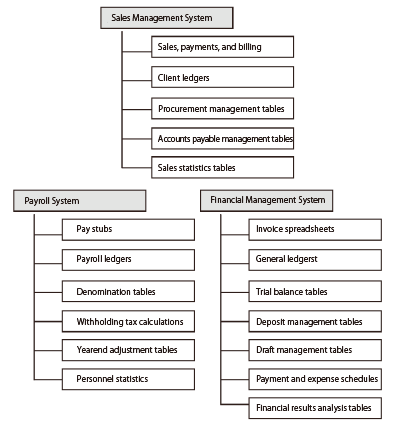BMOS was the operating system for the FACOM Bm office computer announced in December 1977. It was developed jointly by Fujitsu, USAC Electronic Industrial (which later became PFU), and Uchida Yoko. USAC Electronic Industrial produced the FACOM Bm and the identical USAC 820 and Uchida Yoko was responsible for their sales. At the time, because more and more small business and offices required on-site data processing, there was strong demand for Direct Data Processing Systems (DDPS). The FACOM Bm was an office computer on the leading edge of DDPS. (The Bm designation was derived from “billing & branch machine.”) The FACOM Bm was designed to serve the three different usage configurations below. BMOS provided the functionality to support the aims of each application.
- (1)Billing computer
- BMOS came with the following characteristic functions for on-site billing processes.
- Simultaneous invoice and ledger entries
- Inventory and other inquiries
- Inventory and other real-time updates
- Transaction data output to a floppy disk in tandem with the billing process
- (2)Branch computer
- In this usage configuration, on-site data stored on floppy disks or cassette tapes was batch processed at the host computer without an online connection with the host computer. Functions were in demand that enabled the input of business task data on a standalone machine.
- (3)Terminal computer
- In this application, the FACOM Bm machine served as an intelligent terminal to a host computer. BMOS included functions to quickly forward data processed on site in real time to the host computer via a public communication line or a leased communication line.
Fujitsu provided a full-featured operating system called UNIOS for the FACOM V series, which was rolled out at the same time as the FACOM Bm. UNIOS provided all the general-purpose functions for an office computer. The aim of the FACOM Bm, on the other hand, was the user friendliness of a billing machine. Thus, BMOS, while continuing the trend started with the basic USAC 720/10 software and UNIOS/F1, kept the core operating system functions compact and emphasized the provision of user-friendly functions for end users who used FACOM Bm machines for billing and other office tasks. The FACOM Bm became the seed for later office computers furnished with workstation functions.
- (1)Control programs
- Most of the basic functions (such as I/O control, program loader, and online control) on the FACOM Bm were implemented in firmware. The machines had a relatively simple control program structure, consisting of file control, message control, program debugging tools, etc.
- (2)Language processing programs
- BMOS came with BOL-1 (which stood for “Billing Oriented Language-1”), which was a language processing program that let end users easily create programs for billing processes and batch processes. BOL-1 had the following features.
- Simplified statements
- Standardized programs
- Standardized data
- Easy program maintenance
- Easily standardized operations
- (3)Service programs
- BMOS came with utilities that simplified on-site data processing for end users.
- System utilities
A group of functions that supported initializing floppy disks and cassette tapes, reserving file space, printing file content, and storing programs on floppy disks. - Service utilities
These included a file generator that created, modified, updated, duplicated, and verified files and a sort/merge function that sorted and merged files. - Language support utilities
These included a program to register and delete created executable programs and a library editor for registering, modifying, and listing source programs.
- System utilities
- (4)Online processing programs
- BMOS included ONLGE (which stood for “Online Generate Utility”), which allowed users to quickly and easily create online processing programs by simply setting a number of parameters. Table 1 lists the functions of ONLGE.
| Type of communication line | Function name | Description |
|---|---|---|
| Public | Online function 1 (LINE 1) | Sends input file data via a public communication line |
| Online function 2 (LINE 2) | Receives data sent via a pubic communication line and writes the data to an output file | |
| Leased | Online function 3 (LINE 3) | Sends input file data via a leased communication line |
| Online function 4 (LINE 4) | Receives data sent via a leased communication line and writes the data to an output file |
-
BMOS supplied other libraries intended to cut development costs of application programs and shorten development cycles. These were collections of industry-specific and task-specific user practices. These packages were supplied under the name of CAPSEL (which stood for “Customer Applications Service Library”) on the FACOM V series and under the name of SAMPLE (which stood for “Standard Application Making Program Library Editor”) on the FACOM Bm . Figure 1 illustrates how SAMPLE was organized.


